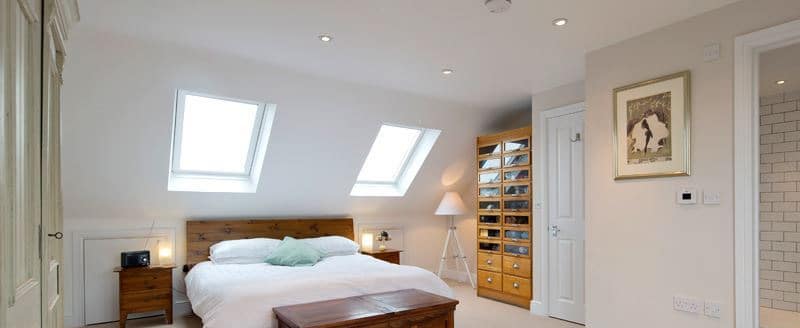More and more of us these days are thinking about extending upwards and creating an additional bedroom or playroom in the roof spaces of our homes. A loft conversion can provide some much-needed extra space for a growing family and really add value to your home.

How much value does a loft conversion add?
Recent research carried out by the Nationwide Building Society has shown that by converting a loft space, your house value can increase by as much as 20%. In areas where average house prices are high, this increase can amount to a considerable sum.
A loft conversion is appealing as it makes use of ‘dead’ space to create an extra room, rather than eating into an outside area in the way of typical extensions. It often costs less per square metre to convert a loft rather than build a conventional extension, as much of the structure you need is already in place.
Most loft conversions can be carried out without planning permission as long as they don’t exceed a certain size (40 cubic metres for a terrace or 50 cubic metres for a detached house) or they have not been designed to protrude too much from the existing roof.
As well as creating the extra space and adding value, a loft conversion can even make your home more energy-efficient. All that extra insulation can help bring down the cost of your utility bills.
What are the different types of loft conversion? 4 loft conversion ideas for different properties
- Roof light conversion– the cheapest and least disruptive where just skylight windows, flooring and a staircase are added to make the room habitable.
- Dormer conversion – where a (generally flat roof) extension protruding from the slope of the roof is built. The most popular type of conversion, suitable for pretty much any house with a sloping roof.
- Hip-to-gable conversion – these work by extending the sloping ‘hip’ roof at the side of your property outwards to create a vertical ‘gable’ wall.
- Mansard conversion – generally the most costly, involving an extension running the whole length of a house’s roof, altering its angle to make it almost vertical.
What to consider with a loft conversion
Feasibility and loft conversion cost
The cost of a loft conversion will depend on many factors such as the age of your house and the shape/pitch of your existing roof. Creating a loft space that doesn’t turn out to be very expensive or complicated is dependent on the following factors:
- Having sufficient head room in the loft space (a minimum of 2.2 metres). As soon as you need to extend the roof space, it will have quite an impact on the overall cost and scope of the building works.
- If the floor joists aren’t strong enough, you will need to introduce deeper joists and/or steelwork to support the loadings.
- Having enough room on the floor below to provide a staircase that complies with the Building Regulations, in terms of fire escape and protection.
An architect, builder or specialist loft conversion company will be able be advise you on potential designs, what you will need to have in place in order to comply with the Building Regulations, or if in fact you will require planning permission. To be on the safe side, check with your local planning authority before starting any work.
Practical matters
You need to consider that by converting your loft, you will be losing a significant amount of storage space. Whilst it will provide a good opportunity for a good clear out, you will need to create space in a garage or shed for all the items you want to keep hold of.
You will also need to be prepared for a prolonged period of disruption. The time taken to complete loft conversations is often much longer than a builder will let on. The usual timeframe quoted of six to eight weeks doesn’t account for all the finishing touches such as laying flooring, decorating and building in storage.
There will be fair amount of dust and mess to deal with for several weeks. Everyone has different levels of tolerance, but even the most laid back of us, will be wanting to do a daily hoover-up while the worst of the building works are going on.
Unfortunately, existing carpets and furnishings on lower floors can take a bit of a battering in the process. It’s not uncommon to have to re-carpet the entire house once the builders have ground in a load of dust and plaster. It pays to make sure you have a bit extra in the budget for additional redecorating post-completion.
If you decide to upsize instead
If you do decide that you can’t face a large building project, then it might make sense to look at upgrading to a bigger property. It may also be the best solution if your property isn’t suitable in any way or if you don’t expect to stay in the property for over a couple more years. If you won’t get to benefit from the extension for long, then it can be hard to justify the significant financial investment and the upheaval involved while the works are taking place.
Taking a step up the property ladder in order to gain the desired extra space, can be more than worth it, even if you are staying in the local area. We would be happy to provide you with a no-obligation valuation on your property and advise you what homes like yours have recently sold for.
Having our finger on the pulse of local market conditions, we can advise that there is currently plenty of movement in the housing market, as those who have been stalling due to the ongoing Brexit negotiations, seem to be finally making a move. Our recent blog looking at whether now is a good time to move outlines reasons why now could be a very good time to upsize.
There are, of course, costs (such as solicitor’s fees and stamp duty) involved with moving that need to be weighed up against the cost of carrying out a loft conversion. You may also need to extend your mortgage, so you will need to find out if your current one is portable and what the rates would be if you need to borrow more. With our local knowledge, we’d be happy to point you in the direction of recommended solicitors and independent financial advisors.
Much like carrying out a loft conversion, moving home can also be a long process, but with the right support it needn’t be an ordeal. Talk to us today if you’d like some free advice about whether it would be worth carrying out a loft conversion, or if you are looking to take the next step on the property ladder. Call us on Wokingham 0118 977 6776 or Crowthorne 01344 779 999.


